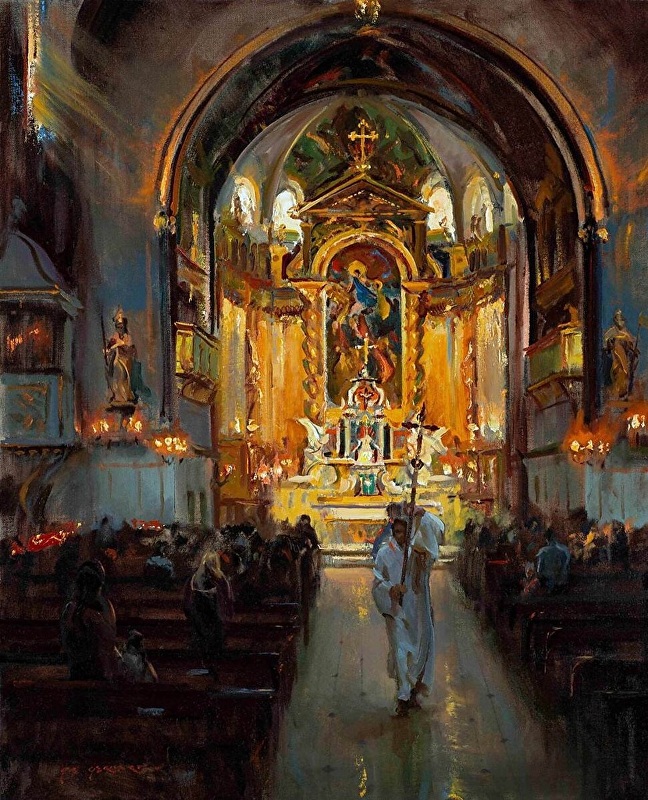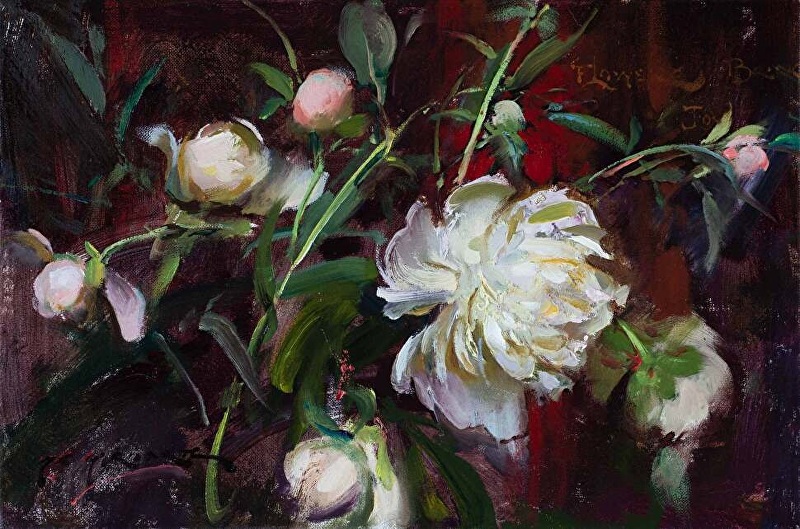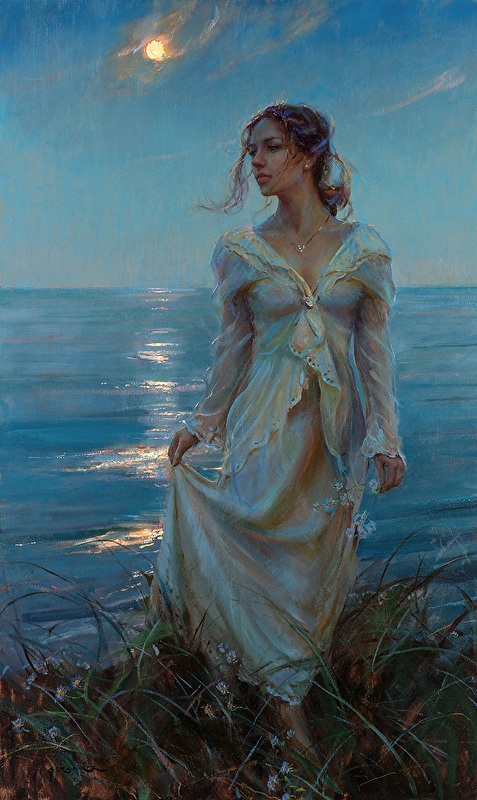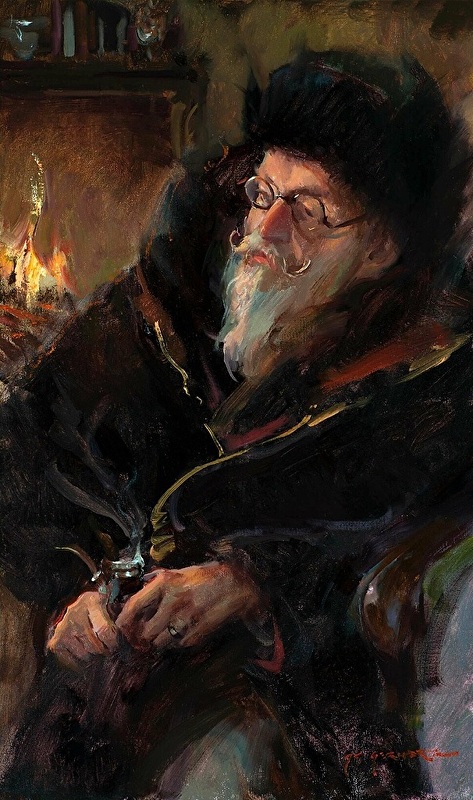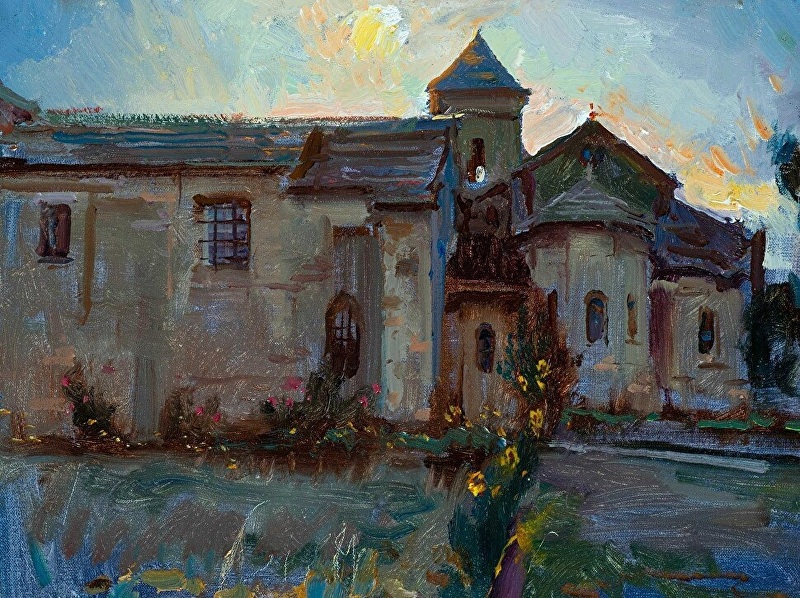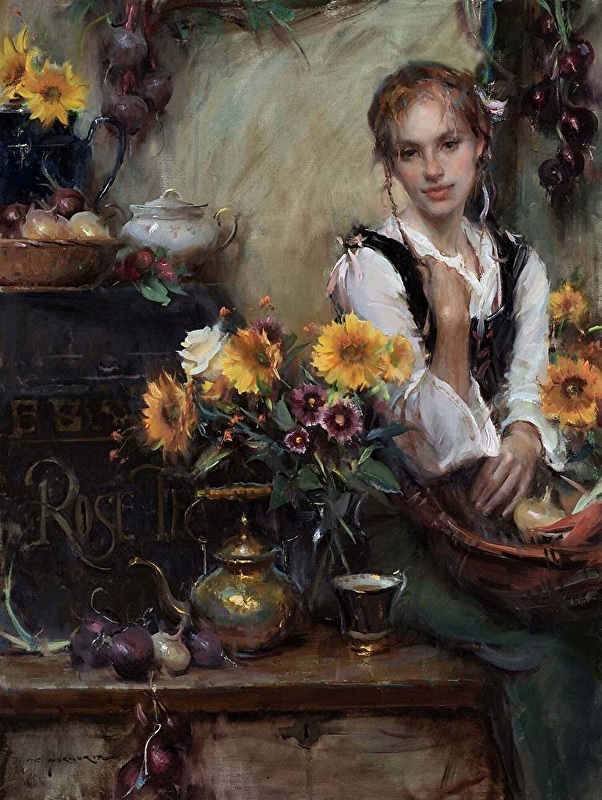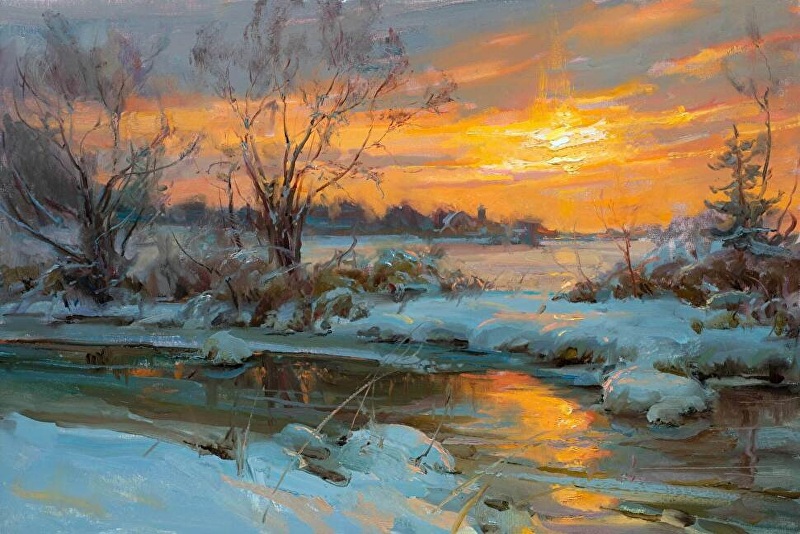Hi John,
We've been posting blogs for a while now over on our BoldBrush Studio blog page. It's mostly art, art history, and some artist interviews. Our goal with this blog is to publish content that serves as a place for artists to learn their craft.
As such, we wanted to make it a little easier for you to get access to the best of this content, so we'll be sending a newsletter about once a week straight to your inbox so you don't miss out.
There will be a button at the bottom of each newsletter directing you back to the blog page itself so you can select other articles to read at your leisure.
We hope you enjoy today's selection, BoldBrush Studio Team |
Visual Inspiration: An Interview with Dan Gerhartz |
Daniel Gerhartz is an award-winning figurative painter located in Wisconsin. He studied at the American Academy of Art in Chicago and mentored with renowned American artist Richard Schmid. Since then he has been featured in solo and group shows across the country and has won numerous awards at prominent national invitational exhibitions, and his work has been collected both nationally and internationally. He has taught, both workshops and one-on-one mentoring, for over 25 years. |
What are you working on right now? What is occupying you in your paintings lately? Well, I just finished a series of small ballet pieces exploring the harmonies and designs created by ballet dancers. A lot of what I do is so visually driven, that even though the subject matter is a ballet dancer, for me it's as much about the abstract concepts as it is about the dancer. Any of the subject matters that I choose is really just a vehicle to get to what I find the most interesting: studying all the beauty that the creation holds. And when I'm honest about my response to the beauty that I take in and simply try to record that, that's when I'm most effective as a visual communicator.
When you say that you're inspired by the design of the dancers, how does that relate to the way you react with light, because light is also very important in your paintings. How do design and light interact for you? That's a great question. We're talking about two different aspects of what we're seeing. Light highlights the forms in the lines. There are many different types of light: soft light, hard light, warm light, cool light, and all of these different aspects of light play into the mood that the piece carries. When I think of the creation, it's so amazingly complex. I just did a dried rose still life last week, and even with this simple dead rose, there's lines and proportions between each of these elements that are just staggering. As you move it, it's a sculpture. Look at the color of this violet on the cool light, and then the warmth of the light on this side, and combined with the beauty of the line it's just stunning. I believe it was created with the intention to arouse a response and my response, my first guttural response to seeing that, is to praise. Who did this? And what am I supposed to do about that? My reaction is Oh, my God, literally, oh, what have you done? This is staggering. This beauty is so wonderful, I have to share it. When we experience something wonderful, whether it be a sunset or a delicious meal or a fine wine, after the first delight of sensation, the next reaction we have is to want to share it. We don't just sit on it. I want to say, Hey, come look at this, doesn't this move you? That's what art is for me: putting myself in a position to be inspired. But that doesn't take much effort, because all you have to do is open your eyes. Beauty is everywhere. Of course there are days when it's cloudy, it's dreary, life is hard. Some days, it's hard to see the beauty, myself included. But when I do see it, if I can just take it in and push it back out, that's my job as a visual communicator. |
To go back to the example of the rose, when you're painting a simple object like this, are you focusing on just one aspect of what you see? Or are you focusing on the whole thing? That's a good question. It can be any aspect of what I see. Yesterday it may have been the color of the rose. Tomorrow, it might be the line of the stem against the background; different things hit you at different times. Sometimes I go into a painting with a plan such as "I really want to explore harmony today." But sometimes I just go into a painting completely open and just plop the subject down and paint. And then try to develop the painting out of it. For me, a painting often starts with harmony in line. I'll think about how I want to break up the picture plane; maybe today that's all I want to say in terms of line. And then what value pattern do I want that to fit into? Maybe I want it mostly dark with just a ribbon of light. For me, it starts that simply. And then I build off of that.
In in both your own work and that of the artists you admire - Sorolla, Fechin, and Sargent, to name a few, I can see that your taste sits right in between Impressionism and Classical Realism. How much was your style influenced by these artists? I also need to add one more name to that, Alphonse Mucha. I am a huge Mucha fan: I just love his design work, and his harmony in line is out of this world. But to answer your question, I love it all. Two years ago there was a huge Bouguereau show that came to Milwaukee. I love his work. It's staggering in its subtlety and draftsmanship and design. I mean, the guy was fantastic and incredibly prolific. I can't believe the number of massive works the guy put out. I also love the work of the Russian impressionists, Repin and Levitan and Fechin and Serov. There was another guy, Carl Marr, who was a German academic who lived at the same time that Sergeant did. He taught in the Munich Academy, and was a fantastic draftsman. He was as good a painter as Sargent. And Sorolla, he did the whole realm from tight classical realism to just gorgeous impressionistic work. Sargent and Dennis Miller Bunker and Jules Bastien-Lepage were also fluent in both impressionist and classical styles. There are so many great artists, and I like different aspects of all of their art. I'm moved to do work that's inspired by all of it, but I try not to too much think about technique. When I first started art school I studied illustration for a while, and in illustration school technique was a huge deal. That's what they taught you to focus on. It was certainly good training. But as I was struggling to find my voice through it all, I came across a quote by C S Lewis. He was talking about originality in general; he said, if you're trying to be original, chances are you won't be. But if you simply try to tell the truth, ninety-nine times out of a hundred, you'll be original without really noticing it. So that's what I've tried to do with my art: to simply tell the truth, to stand in front of a subject and be moved by it. And then trust that all of the inspiration and study that I've done of other artists will work its way out. And it does. But when I sit there and try to fabricate a technique on a painting - for example, try to paint like Fechin - well, it just comes off as false. I've seen other artists do that, and it never comes off as true. So in my own work, I try to abandon, to a degree, what I know about technique and simply work. I ask myself, How am I inspired? What inspires me about the subject right now? And then what do I need to do to get that down as effectively as I can to communicate what inspired me? |
That's a good answer. Jumping off of that, do you have advice on how to study other painters without consciously or subconsciously copying them? Certainly. I've done lots of copies of artists, and I encourage my students to do it regularly. Because can you imagine studying piano and never playing Chopin? I mean, that's all you do. That's all piano lessons are, playing someone else's music. And it makes sense we would do the same thing when learning to paint. So when it comes to copying, the big thing is, what is it about their work that you like? Try to focus on that nuance. You don't have to do, and I don't really encourage, a corner-to-corner copy of the piece; that doesn't really help you. But maybe it was the subtlety with which Mucha could handle the transition between light and shadow that interested you; you could do a small study of a corner of a painting that shows that aspect really well, just to figure out how he did it. That's all I'll do in a copy. I'm not trying to figure out his entire technique, but see what can I learn from his work that's going to increase my own ability to see accurately.
Another thing I notice in your work is strong value contrast. What is it about the contrast between light and dark that draws you in a subject? I just love the power that it brings. Viewer engagement is what you're after in a painting, and contrast is one of the first things that draws a viewer in. It doesn't have to be everywhere in the piece, it can be just in a small section, but it's very effective. You don't need color to evoke emotion; you need to convey a sense of light. I don't want my paintings to look like paint; I want them to feel like air and light. When I go to a museum and am moved by works of art, it's usually the ones that convey a sense of light that touch me. It's stunning when you can almost enter the environment, when you can feel the air. I love juicy, gutsy brushwork too, but more often than not, an emotional reaction comes from the visceral quality that has to do with mood and emotion evoked by a quality of light. Richard Schmid, one of my mentors, said one thing that I always remember: the world doesn't need just another painting. The world needs another great painting. So I try to think about how, with every painting, I can make this the most powerful image I can. And that begs the question, what is a powerful image and how do I make one? Strong graphic shapes is a big part of that equation. The reason we need to learn how to use color effectively is because it enables us to keep the value masses flat. We can change the form of a flat mass with color, giving it form while keeping the shapes graphic and simple, creating strong, powerful images. So that's at the forefront of my mind: what am I thinking? What am I wanting to do? What am I trying to say? What am I painting these days? Well, hopefully strong, powerful images. Really, that's where I start. That can encompass a lot of different design possibilities. |
It can be hard to talk about painting because there's so many elements that go into it. But I know you teach, so I'm sure you are used to the process of breaking it down into bite-sized pieces. Is it still challenging, after even after teaching for so many years? Teaching is one thing that comes fairly naturally to me. And I think it's because the way I think is really quite simple. Painting isn't that difficult. It takes a lot of practice, but the principles are fairly simple. Comparing everything to everything else, and doing your best to get them in the right relationships, basically, is what we're talking about. And then working in proportion, in color and value. All those things, if we just set up some sort of a hierarchical system and know where our boundaries are, allow us to make sense of what we're painting. You'll have painting down if you can get your mind all the way around that! And it's important to forget about what you think you're seeing, and pay attention to what you're actually seeing. I've taught for many years and it always comes down to two or three things - value control and edge control. And drawing. But accurate values and edges really separate the best from the good-to-mediocre. The artists we love are the ones that have impeccable value control and edge work. It's something that's not often taught in art school, but attention to edges is essential; there aren't any laws other than squinting down at the subject, and if the edge doesn't disappear, put it in! Comparing which transition is sharper than the other. It's very simple really. Students want to put in all the edges and forget to squint and look for the lost edges.
Who are some of your favorite current artists working today? Michael Klein. HIs work reminds me of Fantin-Latour; he does beautiful work. And then T. Allen Lawson's landscapes are stunning. Richard Schmid's work certainly; he was an important mentor to me and a big inspiration in my career. David Leffel and Sherri McGraw and Dan Sprick. Then there are California painters doing some amazing work, like Daniel Keys. Rose Franzen. Nancy Guzick. There are so many really talented artists working today!
Is there one thing in all of this work that is a common thread that draws you in? For one, they're good designers. Two, they paint air and light authentically. They have good value control. Those are the main things. Storytelling to a degree.
How important do you think storytelling is for a fine artist? I think it can be very important. I've done some pieces that are more story-oriented than others, and I want to do more - I love the inspiration from stories and songs. But sometimes when I try to paint a story, it can become too literal and I over-tell it. I have to remember to leave some mystery and room for interpretation. I've done pieces that were explicitly Christian in theme, and when I finished them I thought they were moving, but in a gallery people will walk right past them and be more drawn to a painting I did of a bush of cranberries with no narrative at all.
Why do you think that is? Maybe because I left the true inspiration and it became about what I wanted to say rather than what the Lord was inspiring me to paint. There can be a humility and honesty in a carefully observed still life that will resonate more with me than the most elaborately worked-out story. There's a fine line there. Am I trying to brag or am I trying to glorify God? I think that attitude will show in your work. Inspiration: what is it? what are we trying to fabricate, how do we discern true inspiration from false, and how do we paint it?
Great question! How do you discern true inspiration? The answer is given by the quality of the work. If the painting is successful, then I know I'm on the right course, provided it's sending a good message. That's what I base it on; I have nothing else to go on. You know John Waterhouse's Lady of Shalott or Bastien-Lepage's Joan of Arc? Those have strong narratives AND they're stunning works of art. I think often paintings have two narratives - one is a visual narrative, and one is a 'written' or story narrative. Throughout my career I've been primarily inspired by the visual narrative. But I've done a few paintings that have been inspired by story narrative. |
Right, a painting doesn't need to have a verbal narrative. It can be a visual response to something you see in the world. Yes, but's often a visual response to the verbal narrative of your life. There's something that absolutely staggers me and I'm not sure if I need to just keep painting it, or put it into words: the fact that God is such a big part of the equation in our creativity. As artists, isn't there someone we need to thank here? Are we going to experience all of this creativity and not praise God for it? It just seems so obvious. You read the Psalms and they're so much about acknowledging God for being present in all of our being. What does that look like as an artist? For me, I praise God by painting beautiful things, but sometimes I want to say more with words. My wife tells me not to overthink it but to just respond as best I know how and God will put me where I need to be. Oswald Chambers, a fantastic thinker and theologian, said this: "Whenever you say 'I'm going to do something for God', you're missing the whole point." I fall into that a lot. It becomes a pride issue. God doesn't need me for anything, but he might choose to use me for something. I just have to use my talents for the best and trust him with the rest of it. So that's what I try to do with all of it. Stay in His word, listen to Him, and respond. |
And that comes back to art, because in art you also have to come humbly to your subject and not impose your preconceptions on it. Perfectly said! And that's what I try to do, listen to my subject and respond it to the best of my ability. That's what being an artist is all about.
Many thanks to Daniel Gerhartz for this interview! You can view his work on hiswebsiteor stay updated with his latest projects on Instagram. To watch his instructional videos featured on BoldBrush Studio, you can gohere.
|
The BoldBrush Studio Blog is a great way to learn more about art and art history. If you'd like to read other interviews and posts showing great artists and their stories, please click the button below. |
BoldBrush Videos are available for unlimited streaming. This is a DIGITAL CONTENT ONLY product. You will not receive a DVD. |
|
|
|
